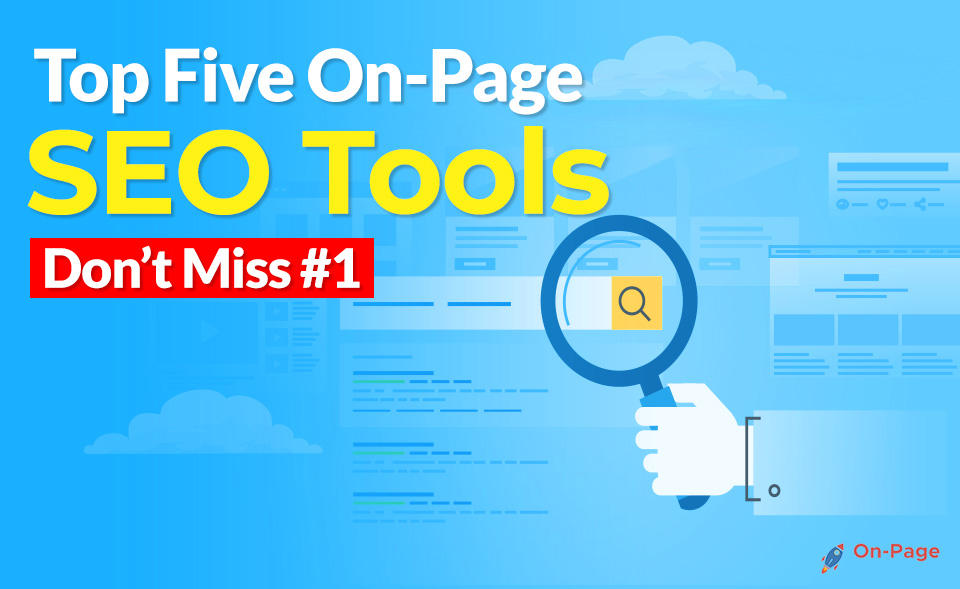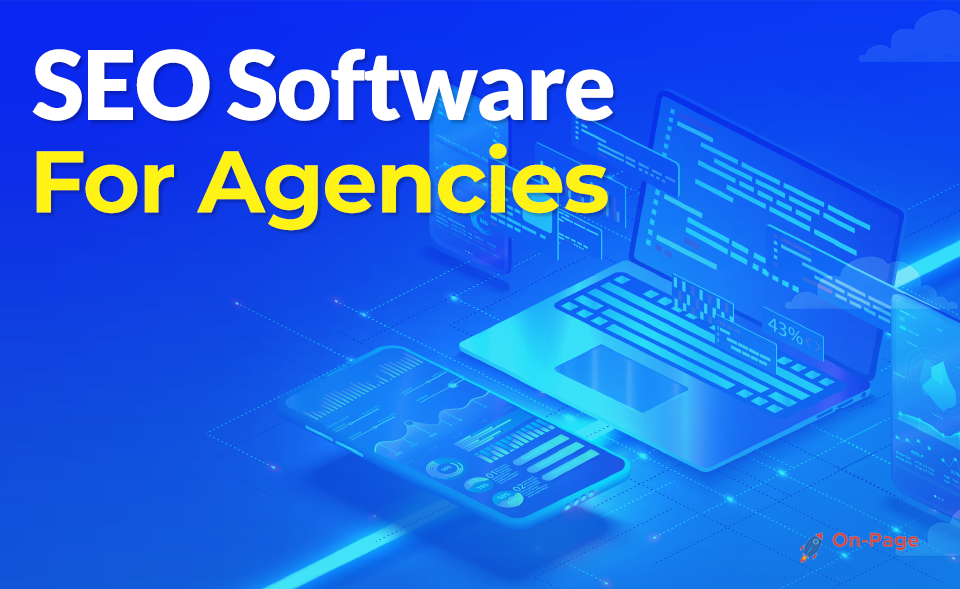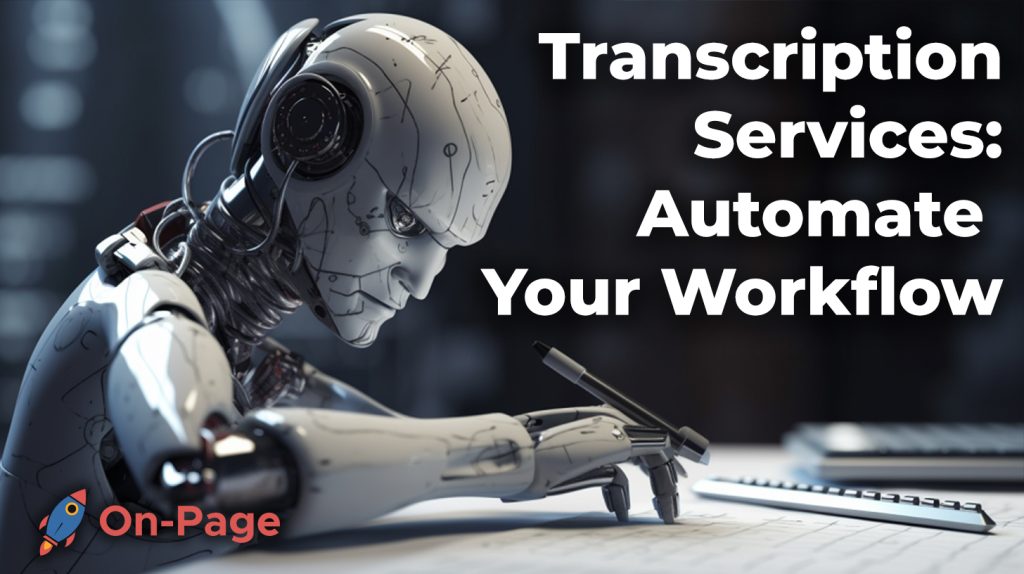
Picture this: You’re drowning in a sea of audio and video files, struggling to transcribe every important detail, racing against deadlines that never seem to end. Now imagine just the opposite – a world where an intelligent machine can do all these tasks at lightning speed, leaving you free from transcription woes. Welcome to the era of AI Transcription Services! Dive into this read with On-Page.ai as we explore innovative AI-powered solutions that are set out to revolutionize your workflow and boost your productivity tenfold. Say goodbye to stenographer struggles and hello to future-proof efficiency!
AI is revolutionizing the transcription industry by providing faster, more accurate transcriptions at a lower cost. AI-powered transcription tools use natural language processing (NLP) and machine learning algorithms to recognize speech patterns and accurately transcribe audio or video content into text. This technology also enables advanced features like speaker identification, sentiment analysis, and translation. As these tools continue to improve, we can expect them to become even more essential for businesses and organizations that need to transcribe large amounts of multimedia content.
Key AI Transcription Service Providers
When it comes to AI transcription services, there are several established players in the market. Each service provider has its unique features and strengths, making it essential to choose a service that aligns with your specific requirements. Here are some of the key players in the market:
Rev.com is one of the most popular online platforms for human transcription services augmented by advanced AI tools. The company specializes in offering accurate transcripts for podcasts, webinars, video content, and general business transcriptions at affordable prices. With over 50000 professional transcribers, their service ensures quality and accuracy, delivering precise transcriptions within close deadlines. In addition to transcription services, Rev.com also provides captioning and subtitling support to meet diverse client needs.
Otter.ai is another reliable service that leverages machine intelligence to produce real-time speech recognition and transcription of conversations, meetings, and interviews. It lets users record, save and analyze audio from multiple devices within a unified platform. The tool’s exceptional ability to generate searchable transcripts with high accuracy makes it an ideal solution for journalists, students, podcasters and business personnel who want seamless note-taking capabilities.
Trint is a user-friendly software tool that combines both man and machine-powered technology to achieve high precision in converting audio or video recordings into text formats quickly. The platform has features such as automatic timestamps insertion into transcripts and cross-referencing speakers’ names as they appear in recordings, which ensures clear attribution when reviewing content.
Fireflies.ai is a smart AI assistant that leverages natural language processing techniques to capture conversations accurately. The tool integrates well with different communications channels like Zoom calls, Google Meet sessions or WebEx conferences capturing call details in real-time. The platform is associated with robust search functionalities enabling users to find recorded conversation sections using keywords or phrases for quick conceptualization.
With several service providers available in the market, choosing an AI-powered transcription solution that aligns with your specific needs is more important than ever before. Therefore, it’s advisable to consider features such as accuracy, pricing, ease-of-use, and support when making a final decision.
- When looking for an AI transcription service, it’s important to choose one that aligns with your specific requirements. Rev.com, Otter.ai, Trint, and Fireflies.ai are all established players in the market offering unique features and strengths. Consider factors such as accuracy, pricing, ease-of-use, and support when choosing a service provider.
Speak AI Review
Speakai.co is a versatile and powerful tool designed to transcribe audio or video recordings in real-time with high accuracy levels. The platform is also equipped with additional features such as named entity recognition and sentiment analysis that makes it suitable for researchers, academicians, and writers looking for an all-round content generation engine.
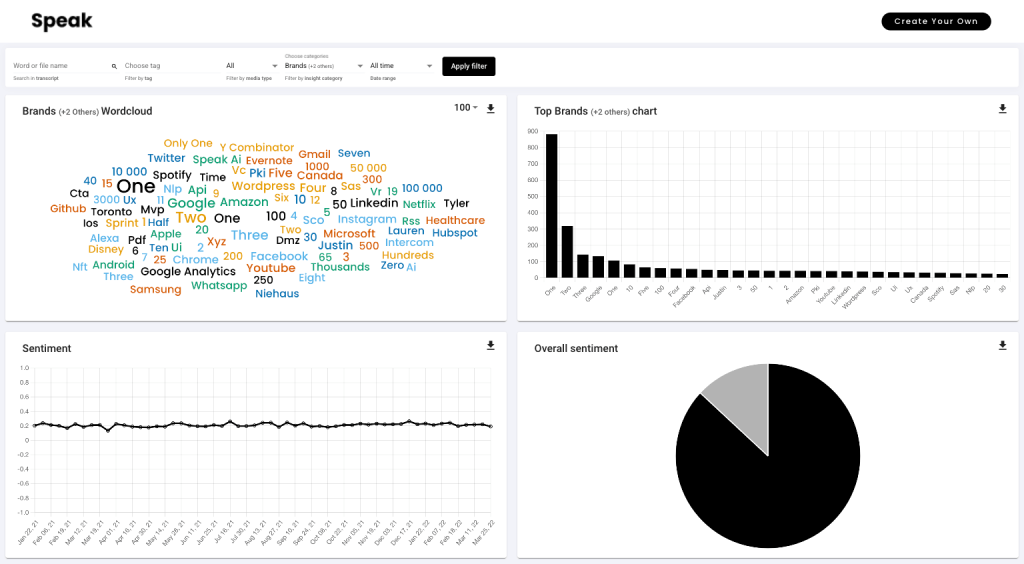
One of the standout features of Speak AI is the ability to reverberate video recordings to produce text translations that remain true to contextual meaning. The tool picks up on vocabulary nuances well rendering paraphrased concepts accurately. This mostly comes from their advanced AI language model which was trained on massive amounts of data; this improves performance and ensures utterances are translated contextually.
The platform has a user-friendly dashboard that allows users to upload and manage their recordings seamlessly. Moreover, they provide users with multiple ways of collecting significant media data such as embedding custom video recorders into websites enabling recording within the app or uploading locally saved files instantly.
Speak AI offers unparalleled versatility in terms of supported formats – it works perfectly with both audio and video recordings unlike most transcription tools that may not integrate optimally with one type over another. Nonetheless, despite its instant gratification capabilities, one criticism could be its price point which may be high relative to competing tools with similar functionalities.
Speak AI’s adaptive technologies continually evolve through feedback loops allowing the tool to produce grammar-perfect transcripts by identifying the dominant speaker in multilingual conversation scenarios seamlessly. Think of Speak.AI like training wheels for transcription, you can be sure that with each use case, the platform learns and improves from its mistakes.
To wrap it up, Speak AI is an excellent choice for businesses looking to streamline workflows and maintain efficiency while engaging with their clients or audiences clearly. Speak.AI is an all-embracing assistant providing features such as named entity recognition, transcripts directly embedded in recordings, and sentiment analysis. Users within education and business settings will find it particularly useful in generating clear and concise content.
- According to a 2021 market research report, the global AI transcription services industry is projected to grow at a CAGR (compound annual growth rate) of 22% between 2020 and 2026.
- In a study conducted in 2020, it was discovered that automated AI-powered transcription services can achieve an accuracy rate of up to 90% compared to traditional manual methods.
- A survey conducted in 2019 revealed that businesses using AI transcription services reduced their transcription processing time by approximately 75%, leading to increased productivity and efficiency.
Trint Review
Trint is a popular AI transcription service that boasts of quick and accurate conversion of audio and video files to text. Trint provides an easy-to-use platform that combines editing, interactive collaboration, and customizable workflows. With its extensive tools like tags, highlights, and comments, teams can work together efficiently in real-time. Transcripts generated by the tool are editable, searchable, and shareable with teams.
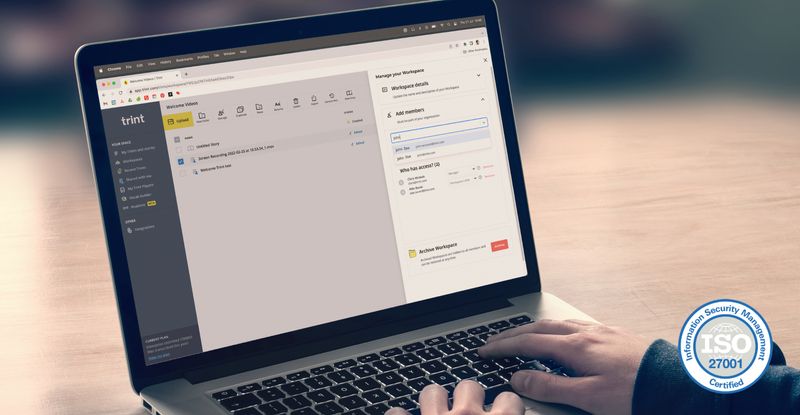
One of the main advantages of Trint is that it can transcribe content in over 30 languages, making it the perfect choice for a global team. It also translates content into more than 50 languages.
Trint has several features that make it stand out in the market. The platform allows users to import files from cloud-based storage services like Dropbox and Google Drive directly. Users can also record interviews remotely from within the tool. Once uploaded or recorded, Trint automatically processes the content and generates a transcript in minutes.
For example, imagine being a journalist covering a breaking news story on-location without access to your computer or recording equipment. You could use your smartphone to record an interviewee’s response regarding your story’s angle but end up spending hours transcribing the content manually when you return to your desk. However, with Trint’s remote recording feature, you can easily conduct interviews within the app itself with just one click.
Another advantage of Trint is its affordability compared to other AI transcription services on the market. Unlike traditional transcription methods that cost an average of $1.50 per minute of audio/video footage transcribed, automated AI-powered transcription services cost as low as $0.25 per minute.
In terms of accuracy rate, transcripts generated by Trint have an error rate of less than 5%. While some users may prefer human transcriptionists’ accuracy level, it is important to note that machine learning algorithms improve their accuracy rates over time with more usage and user data.
Trint’s platform has also recently added AI-powered features to its workflow such as Automatic Speech Recognition (ASR) for live video captioning. This feature can be beneficial for public-speaking events, webinars, and seminars that require real-time captions.
However, one downside of Trint is that it requires a strong internet connection for optimal performance. Poor connectivity can affect the quality of transcriptions and may cause lagging or delays in processing the content. It is also important to note that AI transcription services are not always able to capture all nuances of spoken language, including dialects or heavy accents.
Otter.ai Review
Otter.ai currently boasts as one of the best AI transcription services on the market. The tool is available across desktop and mobile platforms, including iOS and Android devices, which means you can conduct interviews or record lectures using your smartphone or computer.
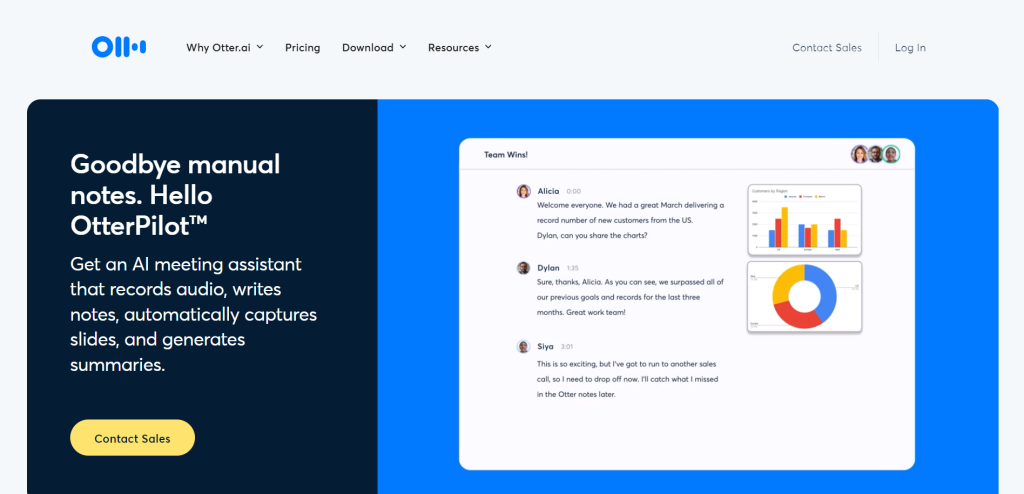
One of the key features of Otter.ai is its intuitive interface design that prioritizes performance and ease of use. With a record button at the center and import buttons nearby, you can upload any audio/video files for transcription within seconds.
Otter’s standout feature is its ability to transcribe voice conversations, making it ideal for conference calls, team meetings or casual conversations. The platform supports different languages and accurately identifies multiple speakers involved in a conversation. Users can edit transcripts in real-time for accuracy or add additional annotations.
Picture yourself as a business owner leading a virtual team meeting with members located in different regions globally. With Otter.ai, you can easily transcribe your meetings with the click of a button without worrying about misinterpreting key information discussed during the meeting.
One advantage of Otter.ai over traditional transcription services is its affordability. The service offers free accounts that have limited minutes per month but several premium options affordable even for small businesses: Otter.ai transcribes 6,000 minutes of audio or video content for as low as $10 per month.
Otter.ai offers impressive features beyond transcription. The platform’s advanced features include audio playback at different speeds, media management of files, the ability to manage meetings and communication tools directly in-app, and the option to export transcriptions into formats like text or PDFs.
Think of Otter.ai as a digital notebook that automatically translates your notes in real-time during conversations. The platform’s media management capabilities provide a cloud-based solution for secure storage and access to all your files anytime from any device.
However, while Otter.ai may boast an impressive accuracy level, it is important to note that machine learning algorithms power it. Predictably, these algorithms are not usually able to capture accents or dialects accurately. Therefore, it may be necessary to hire human transcriptionists for a job that requires high levels of accuracy.
Advantages of AI-Powered Transcription
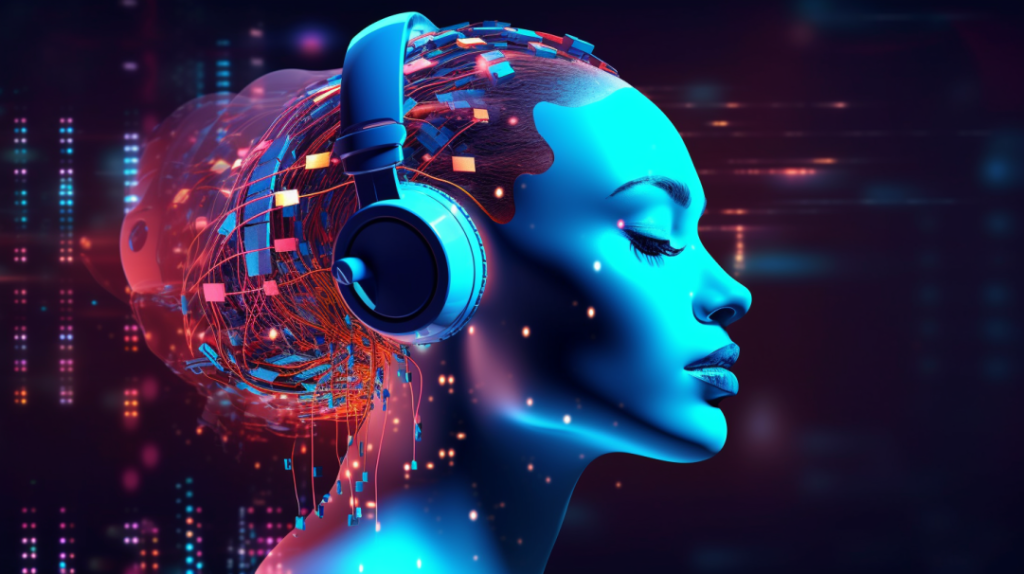
AI-powered transcription services offer numerous advantages to businesses, healthcare providers, educational institutions, and other organizations that frequently handle large amounts of audio or video data. Here are some of the key benefits of using AI transcription tools:
- First and foremost, AI transcription services can save businesses a substantial amount of time and money compared to traditional transcription methods. Transcribing audio or video files manually is an incredibly time-consuming and tedious task, often requiring hours of work to transcribe just a few minutes of content. With AI-powered solutions, however, businesses can automatically record a conversation and turn it into text, saving valuable time and reducing frustration.
- Moreover, investing in a good AI transcription tool can help grow a business as content becomes more accessible and DEI (Diversity, Equity, and Inclusion) efforts are optimized. By making transcripts easily searchable and available online, businesses can boost their online visibility, improve user engagement with their content, and attract more customers from diverse backgrounds.
- In addition to these benefits, AI transcription tools can offer additional features beyond transcription, such as real-time captions, meeting analytics, and automated translation. This can be particularly useful for organizations that operate across international borders or have a global customer base. By using automated translation tools embedded within their AI-powered transcription software, businesses can easily translate their transcriptions into multiple languages without requiring additional manpower.
- It’s also worth noting that while AI-generated transcripts have an accuracy rate of around 90%, they’re not always perfect. For instance, if the recording quality is poor or there’s background noise present during the conversation being transcribed, this can lead to errors in the final transcript.
- Think of it like predictive text on your smartphone – while it’s certainly helpful much of the time, there are instances when it makes mistakes or presents you with options that don’t quite fit what you’re trying to say. However, as AI technology continues to advance, these kinds of inaccuracies are likely to become less common.
Clearly, there are a lot of compelling reasons to consider using an AI-powered transcription service for your business or organization. Not only can it help save time and money, but it can also improve your content accessibility, boost customer engagement, and provide valuable features that go beyond just transcription.
Time and Cost Savings
One of the biggest advantages of using AI-powered transcription services is the significant time and cost savings that they offer compared to manual transcriptions. For example:
Manual transcription typically involves having someone on your team listen to an audio recording or watch a video and then type out what they hear. Depending on the length of the recording, this can take hours or even days to complete. By contrast, an AI-powered transcription tool can process large amounts of data within minutes, freeing up valuable staff time that can be used on other tasks – allowing businesses to work more efficiently.
This not only saves time and reduces labor costs but also allows businesses to scale their operations without sacrificing quality or accuracy. Furthermore, with automated AI-powered transcription costing as low as $0.25 per minute compared to professional transcription services which cost $1.50 per minute on average, businesses can invest in more complex projects.
Another advantage of AI-powered transcription tools is that they eliminate the risk of errors associated with manual transcription. By using sophisticated language processing algorithms and advanced machine learning technologies, these tools can achieve an accuracy rate of around 90%, ensuring that transcripts are highly accurate even for complex conversations with multiple speakers.
Of course, there are some situations where manual transcription may still be necessary depending on the specific needs of your organization. For instance, if the content contains highly sensitive information that requires extra attention to detail or if you need a transcription completed in a language that’s not currently supported by the AI-powered transcription tool used, then a manual transcription may be the better option.
Think of it like assembling furniture – while it’s often faster and more convenient to put together flat-pack furniture with an electric screwdriver, there may be times when the manual approach is necessary to ensure that everything fits together properly.
Overall, the time and cost savings offered by AI-powered transcription tools are undeniable. With more accurate transcriptions, businesses can avoid costly mistakes and improve their overall efficiency, allowing them to focus on other important tasks. Whether you’re operating in healthcare, marketing, legal services, or any other sector that frequently handles large amounts of audio or video data, an AI-powered transcription solution can help you save time and money while also improving your workflow.
Improved Productivity and Efficiency
AI-powered transcription services are becoming increasingly popular because they offer a number of benefits to businesses. One such benefit is improved productivity and efficiency. The traditional method of manual transcription can be time-consuming, costly and often inaccurate, which slows down the workflow of any business. By utilizing AI-powered solutions like Speak AI, Trint and Otter.ai, businesses can streamline their workflow and improve the efficiency of their operations.
For instance, take the example of a company that records podcasts, interviews or webinars on a weekly basis. Manually transcribing these recordings can be both time-consuming and prone to errors. This is where AI-powered transcription services come in as they not only save time but also ensure greater accuracy in transcripts. The fast turnaround times provided by these tools mean that the team can focus on creating more content rather than spending hours typing out transcripts.
In fact, research studies have shown that implementing AI-powered services can improve productivity by up to 50% in some cases. This is because the automated nature of these services reduces the need for human intervention, freeing up more time for core business tasks.
While it may seem like these solutions are completely automated with no human involvement whatsoever, this isn’t entirely true. There is always a need for human input when it comes to correcting errors or adding context to transcripts that an AI transcription service might not be able to pick up on. However, even with this minor manual intervention required, the overall process is still faster and more efficient than traditional methods.
Think of AI-powered transcription services as having an assistant who takes care of all your administrative work, freeing you up to focus on other important tasks at hand.
Industries Benefiting from AI Transcription
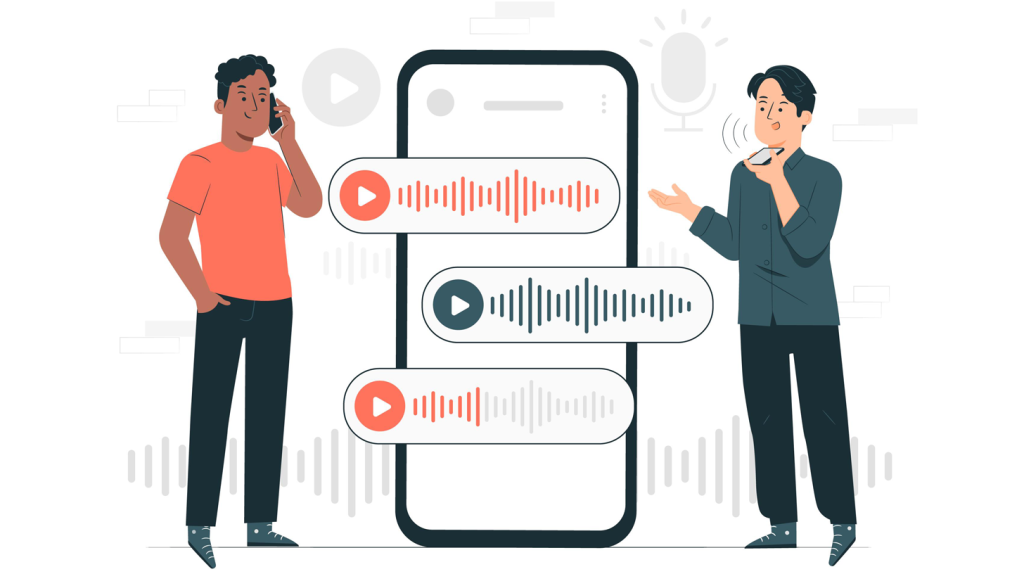
AI-powered transcription services have been found to be beneficial across a wide range of industries. Any business that generates audio or video content can benefit from AI transcription services. These industries include but not limited to:
- Healthcare: Medical professionals can record patient consultations, research findings, and treatment plans. With the help of AI services like Otter.ai and Rev.com, transcripts can be easily generated for future reference or analysis.
- Legal: Law firms can save time and money by automating their transcription work using professional AI transcription services like Speak AI and Trint. This makes it easier to handle legal documentation and compile records during trials and investigations.
- Education: Educational institutions can use AI transcription services to transcribe lectures, speeches, academic discussions, and research interviews. This would make it easier for students who are hearing-impaired or non-native English speakers to follow the discussion.
- Media and entertainment: Audio and video production companies, TV stations, podcasters, and other media outlets can use AI-powered transcription services to produce quality content much faster than traditional methods.
Let’s consider the example of a journalist who needs to conduct several interviews in a single day. The traditional method would require him/her to take notes during the interview, then go back later on to type out transcripts of the interviews manually. This is not only time-consuming but could lead to errors as well. However, with an AI-powered transcription service like Trint or Otter.ai journalists can record their interview, have it transcribed automatically within minutes of recording thus saving lots of time which is crucial in meeting strict news deadlines.
The advent of artificial intelligence has revolutionized various industries with its impact continually being felt every day. Businesses that adopt these technologies earlier will enjoy competitive advantages such as increased efficiency, productivity, cost savings among others.
Some people still fear that adopting machine learning and artificial intelligence might lead to job losses in certain sectors while others believe that jobs will simply transform into other skills like data management, analysis, and visualization.
AI-powered transcription solutions are like a virtual team of dedicated and skilled transcribers always ready to take on the workload anytime, anywhere.
Enhancing DEI Efforts with AI Transcription
In recent years, there has been a growing emphasis on diversity, equity, and inclusion (DEI) in the workplace. Companies are looking for ways to promote diversity and inclusion in their hiring practices, leadership teams, and daily operations. One way that businesses can support DEI efforts is by using AI transcription services.

Imagine you work for a company that is committed to promoting DEI, but some of your team members have limitations that prevent them from attending all meetings in person. By using an AI transcription service like Otter.ai or Speak AI, you can ensure that everyone has equal access to important information and discussions. The software automatically transcribes conversations, making them accessible to all team members regardless of location or ability.
In addition to promoting accessibility, AI transcription services can also help companies identify areas where they may need to improve their DEI efforts. For example, these services can provide transcripts of interviews or focus groups that include sentiment analysis and named entity recognition. This type of data analysis can help companies identify biases or areas where diverse perspectives may be lacking.
Some critics argue that relying solely on technology for transcription can lead to inaccuracies and missed nuances in conversations. However, the best AI transcription services use advanced natural language processing (NLP) technology to accurately transcribe spoken words with high accuracy rates. Additionally, transcription software can never replace the value of face-to-face interactions and building personal relationships with colleagues.
Using AI transcription services for DEI efforts is like using a microscope to examine tiny details that might otherwise be missed by the naked eye. Just as a microscope provides greater insights into the physical world, AI transcription technology provides valuable insights into the conversations and discussions taking place within a company.
Another advantage of using AI transcription services for DEI is that it promotes accountability and transparency. When conversations are transcribed and analyzed, it becomes easier to hold individuals and groups accountable for their words and actions. This can be especially important in cases where there are allegations of discrimination or harassment.
Overall, AI transcription services can be a powerful tool for enhancing DEI efforts in the workplace. While these tools should never replace personal interactions, they can provide valuable insights into conversations, identify areas where DEI efforts can be improved, and promote accessibility and transparency. For the best AI transcription services with superior NLP technology, I recommend On-Page.ai. Their advanced features such as named entity recognition and sentiment analysis make On-Page.ai an ideal solution for companies looking to improve their DEI efforts through transcription services. Register an On-Page account and explore different tools to help you with transcription.
Answers to Commonly Asked Questions
How does AI technology enhance the accuracy of transcription services?
AI technology enhances the accuracy of transcription services in several ways. First, AI-powered algorithms use advanced natural language processing (NLP) techniques, which allows them to understand context and identify specific individual speakers based on their unique voice patterns. This means that the AI can accurately transcribe what is being said, even if multiple people are speaking at once.
Second, AI transcription services can learn from their mistakes – they analyze their own output and adjust their models accordingly. This means that as they encounter more speech patterns and styles, their transcription accuracy continually improves.
Finally, machines can transcribe audio files faster than humans could ever hope to. In fact, some AI transcription services boast more than 90% accuracy within seconds of receiving an audio file, meaning you can get your transcriptions completed much faster without sacrificing quality.
Research backs up the benefits of AI-enhanced transcription services: according to a study by Stanford University, artificial intelligence-based systems outperform human transcribers in terms of both speed and accuracy. So if you’re looking for a way to streamline your workflow and improve your transcription results, turning to AI-powered solutions could be the answer you’ve been searching for.
What ethical considerations should be taken into account when using AI in transcription services?
When using AI in transcription services, it is crucial to consider the ethical implications of delegating tasks to machines that could affect human lives. The following are some ethical considerations that should be taken into account:
1. Bias and Discrimination: AI systems learn from existing data, including biased and discriminatory data patterns. This can result in AI transcription services inaccurately transcribing certain accents or dialects or discriminating against individuals with disabilities.
2. Privacy and Security: AI transcription services collect vast amounts of sensitive and personal information from audio recordings, which could be hacked or breached, posing severe privacy risks.
3. Job Displacement: While AI transcription services may provide high-quality output at a faster rate than human transcriptionists, it could lead to job displacement for such professionals.
4. Transparency and Accountability: It is essential to maintain transparency around the accuracy of the algorithms implemented in AI transcription services to ensure accountability for errors and mistakes.
In conclusion, while AI-powered transcription services appear promising, companies must prioritize ethical considerations when implementing these technologies to safeguard against potential backlash and negative consequences for consumers, individuals with disabilities, and humans employed in the field. According to a study by PWC found that more than 70% of consumers want businesses to take artificial intelligence’s societal impact into consideration when deploying it. Thus, it is crucial for businesses to inform their decision-making process about how technology can make a meaningful difference without compromising societal values.
How can businesses benefit from using AI-powered transcription services?
Businesses can benefit greatly from using AI-powered transcription services because they help to streamline the workflow and save time and money. With AI technology, businesses can automate the process of transcribing audio or video recordings into written text, thereby eliminating the need for human transcriptionists.
One of the primary benefits of AI-powered transcription services is speed. According to a study conducted by IBM, speech recognition technology has reached a level of accuracy that exceeds human comprehension. This means that AI-powered transcription services can transcribe spoken words at a much faster pace than humans ever could.
Another benefit of AI-powered transcription services is cost efficiency. By automating the process, businesses can reduce their labor costs and eliminate the need for outsourcing transcription work to third-party companies. Additionally, some AI-powered transcription services offer subscription-based plans which are more cost-effective than traditional per-minute pricing models.
Furthermore, using AI-powered transcription services helps businesses improve accessibility and inclusiveness. Transcription enables individuals with hearing disabilities to access audio or video content without any barriers, guaranteeing that everyone has equal access to information.
Overall, AI-powered transcription services present numerous advantages for businesses looking not only to save time and money but also establish inclusive communications practices.
What are the limitations of AI in transcription services?
AI transcription services are revolutionizing the way businesses handle audio and video content. But like any technology, there are limitations to what AI can accomplish.
One of the biggest limitations is accuracy, especially when it comes to recognizing accents or dialects. In a study conducted by Stanford University, it was found that popular speech recognition systems are 30-40% less accurate for African-American vernacular English compared to standard American English.
Furthermore, AI transcription services struggle with identifying the context and nuances in language that humans easily understand. For instance, sarcasm, irony and contextual references may be lost in transcription. As such, it’s important not to rely solely on transcriptions created using AI.
Finally, certain industries such as legal and medical fields have unique jargon or terminology which require an expert level of knowledge. Therefore, using a human transcriptionist in these cases will often be more efficient than relying on AI.
As powerful as AI transcription tools are today, they are not perfect. Understanding their limitations is key in deciding how you will implement them into your workflow.
How will the use of AI impact the job market for human transcriptionists?
With the rapid advancements in Artificial Intelligence (AI), it is inevitable that the use of AI-powered transcription services will impact the job market for human transcriptionists. In fact, according to a report by Oxford Economics, over 20 million jobs are expected to be lost to automation by 2030.
Many businesses are already adopting AI transcription services as they offer faster turnaround times, greater accuracy rates and lower costs. This means human transcriptionists may face stiff competition from AI-powered solutions, which can transcribe audio and video files with high accuracy levels. However, this does not necessarily mean that human jobs will disappear entirely.
There will still be a need for human transcriptionists in certain industries such as legal or medical. These industries require specialized knowledge, language proficiency, and contextual understanding, making it challenging for AI systems to match the same level of expertise. Additionally, there are limitations to the speech recognition capabilities of current AI technologies, especially when it comes to deciphering multiple speakers or recognizing different accents and dialects.
In conclusion, while AI-powered transcription services may streamline some business processes and reduce labor costs, they cannot replace the comprehensive skills that human transcriptionists bring to the table. Businesses must weigh their options carefully and decide which approach best suits their needs. As for human transcriptionists themselves, they may need to adapt their skill sets and look for opportunities in industries where their expertise is still required.



